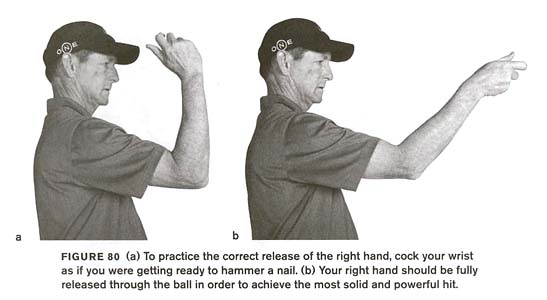It's like drawing back a bow (and arrow), you want to create coil so the release is natural and without thought - and able to apply tremendous acceleration when needed.
Try doing the same thing, with one difference.
Cock the wrist up by putting your hand on your hip and lifting the tip up at least to your eye level....even higher is ok.
Now, get into your shooting position keeping your wrist and forearm in that same position....with your wrist fully cocked as you address the cue ball. You may want to constrict your bicep so you can release by straightening your arm slightly.
Getting the wrist in this position will require you to coil more in the shoulder and bicep creating tension....this is good, because the tension you will soon discover is actually coil....then you can release the coiling action and make incredibly accurate contact with the cue ball target (I recommend a slight TOI position).
I can teach this movement in about 2 - 3 hours, it's challenging to describe it in writing, so experiment with the key points I made and let me know how it goes....I can probably get you on the right track with a few more questions, comments and answers.
Check out the picture of my friend Hank Haney demonstrating the wrist action in the golf swing.....it's very similar, just in a compact form because of the bridge hand's role.

I didn't realize that I use it until you started posting about the hammer stroke. I always thought I cocked my wrist forward during the stroke. It wasn't until I tried to do it that I saw I was already using it.
I don't know if I've always done it this way. I remember working on cocking my wrist forward, which is the opposite of the hammer stroke when I was first learning how to shoot. Some where in between then and now, I developed the hammer stroke.
Concentrating on a slower backswing keeps my length consistent. I only use a shorter backswing when I need to punch the cue ball or I'm shooting a short distance. I have a hard time controlling my speed with a short backswing and power shots although I see some guys that are able to pull this off. I can't.
I like to think about accelerating the cue stick, even on soft shots. When I'm hitting the balls well, my follow through is short and straight. I know I hit the cue ball where I'm aiming. Using a longer follow through, I sometimes have a tendency to move parts of my arm/wrist and not stroke straight through the cue ball.
Even though the follow through is not what hits the cue ball, setting it up correctly gets me contacting the cue ball with the correct angle of attack and speed.
Best,
Mike

